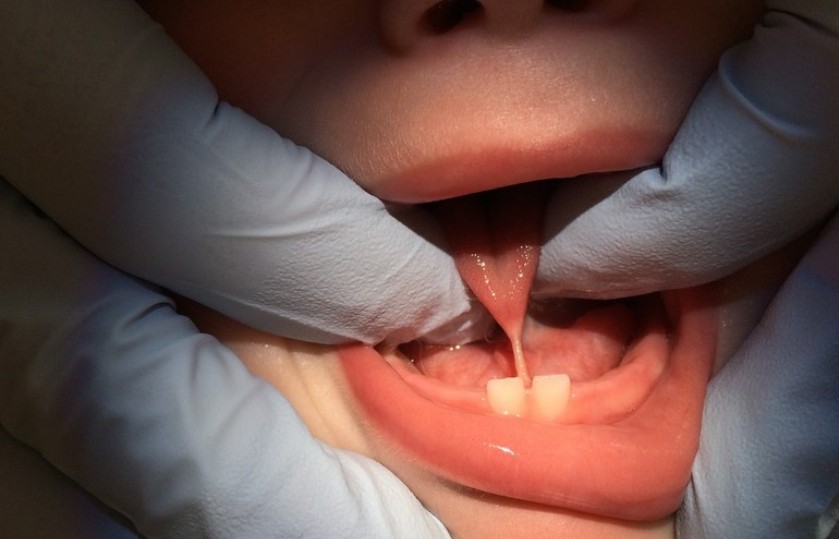Tongue-Tie (Ankyloglossia): What It Is, Symptoms And Treatment

Tongue-tie ( Ankyloglossia) occurs in a significant percentage of newborn babies. Left untreated, tongue-ties can lead to problems with feeding – including weight loss. Learning what a tongue-tie is and how it can affect babies might help you to spot the condition in your own child, find treatment and prevent avoidable problems later on.
READ ALSO: 5 Reasons Your Baby Is Not Gaining Weight And What To Do
What Is A Tongue-Tie?
A tongue-tie (also known as Ankyloglossia) occurs when a short or tight membrane under the tongue restricts its movement. Usually the strip of skin connecting the baby’s tongue to the floor of their mouth is shorter than usual. While some babies who have tongue-tie don’t seem to be bothered by it, in others, it can restrict the tongue’s movement, making it harder to breastfeed. The condition also varies in severity.
What Are The Problems Associated With A Tongue-Tie?
Tongue-ties generally cause problems with feeding; see some of the problems with the condition below:
Breastfeeding Problems
To latch correctly, a baby needs to get a mouthful of the mother’s breast in his mouth to successfully breastfeed but a tongue-tie restricts movement and can prevent him from opening his mouth widely enough to do this and means that he’ll be unable to feed properly. This will consequently affect his weight gain.
READ ALSO: Tongue-tie in Babies: 5 Typical Signs to Watch Out For
All of the above problems with a baby’s feeding can affect the breastfeeding mum also in the following ways;
- Sore or cracked nipples: caused by your baby’s inability to latch effectively.
- Low Milk Supply: Milk production is based on a feedback mechanism. When your baby sucks effectively, it sends signal to the brain to produce more milk. The reverse is true when your baby isn’t sucking properly.
- Engorged Breasts: This is the result of your baby not draining your milk supply.
- Mastitis: This is an inflammation of the breast which may keep recurring due to poor latching and feeding.
Most breastfeeding problems, however, aren’t caused by tongue-tie and can be overcome with the right support.
How Can I Tell If My Baby Has A Tongue-Tie?
If you are concerned that your baby has a tongue-tie, you should speak with your baby’s doctor but the following signs may help you deduce if the condition is present in your child:
- Actually Seeing It: When your baby opens his mouth, check to see if the tip of his tongue looks slightly heart-shaped. Not all ties are visible, particularly those at the back of the mouth, but you may notice an obvious one.
- Restricted Mouth or Tongue Movement: If you find that your baby has trouble opening his mouth or sticking out his tongue, it could be he has a tongue-tie.
- Latching Problems: Even if your baby is able to latch properly initially but has problems maintaining a latch during breastfeeding, he could have a tongue-tie.
- Unsettled After A Feed: This could mean he is not getting his fill and may still be hungry.
- Clicking Noises or Biting When Feeding
- Poor Weight Gain: If your baby isn’t gaining weight as he should, have your midwife or doctor examine him to see if a tongue-tie is interfering with his feeding.
Diagnosis
Tongue-tie is sometimes diagnosed during a baby’s routine newborn check, but it’s not always easy to spot. It may not become apparent until your baby has problems feeding. The health professional assessing your baby for a tongue-tie, will check for tongue movement. If your baby’s tongue doesn’t touch the roof of his mouth or he can’t stick it out, a doctor is likely to consider this a strong sign of a tie.
Treatment
If the tongue-tie is considered mild and not causing you or your baby any problems then you may be advised to let go of treatment. Sometimes the condition can correct itself as the skin stretches out over time.
Where a tongue-tie is causing problems to the baby or mother, a ‘tongue-tie division’ procedure is carried out to free up the space beneath the tongue and create more movement by snipping the skin that attaches the tongue to the mouth.
READ ALSO: 5 Signs Your Child Has Tongue-tie
The Procedure
The tongue-tie division procedure may be carried out without anesthesia for babies who are only a few months old or they may be given a local anesthesia that numbs the tongue.
A general anesthetic is usually administered for older babies with teeth, which means they will be unconscious throughout the procedure.
The baby’s head is held securely while sharp, sterile scissors are used to snip the tongue-tie. Some practitioners use a laser instead of scissors. It only takes a few seconds, and you can start feeding your baby immediately afterwards.


